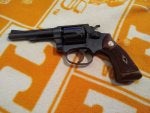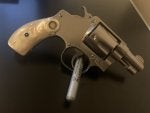Close, but more convoluted than that:
Here's a “nutshell” version of the “.38/32 Terrier” evolution which is applicable to all post war I frames with a few exceptions:
1. Pre War: Introduced in 1935 as a snubby barrel, rd grip version of the 38/32 Regulation Police. Flat mainspring and 6 screws.
2. Post War: Re-introduced in 1948 and know as the Post War Transitional Model.
A. Pre war post war: almost identical to pre war version including 6 screws, barrel and frame markings, and rd top Svc Grips, but with new sliding bar hammer block safety.
B. Pure post war; no patent dates on barrel, 4 line address on frame, some new post war parts, like Mini Magna grips.
3. Improved I frame: late 1951, 5 screws, coil mainspring replaced leaf spring, deletion of tension screw, the 6th screw, no overall size changes.
A. 1st version, rd sight
B. 2nd version ramp front sight with barrel rib, early 1952
4. Model of 1953 NEW I frame forging: 4 and 3 screws, longer, egg shaped trigger guard (deleted 5th screw), and 1/8” longer rd butt grip frame (same changes to the Model of 1953 J frame. Four screws until late 1955, when upper side plate screw (4th screw deleted). These are the Pre Model 32s. NOTE: screw numbering is different than K and N frame because of the order in which they were eliminated.
5. Designated Model 32 June of 1957, Model # stamping didn’t actually occur until 1958.
6. Designated the Model 32-1 Jan 1961, I frame eliminated, .38/32 built on J frame with extended cyl window/frame, and longer cyl.
The Post War I frames are the most convoluted and misunderstood of the S&W Hand Ejectors. Write ups in the SCSW eds. 1 thru 4 exhibit the confusion and lack of discoveries for these models. Although the 4th Ed. on page 144 is my clarification in detail, the I frame sections following it still have the old inaccuracies.
You can see my section in my commentaries here:
http://smith-wessonforum.com/blog.php?u=134353
Although for some reason the commentary links are working sporadically much of the time.










